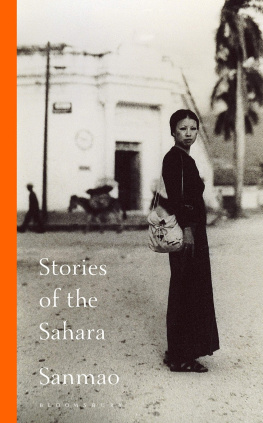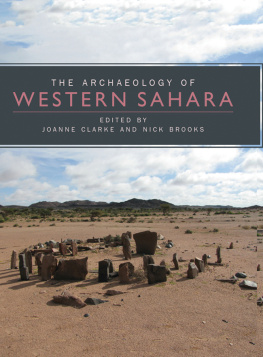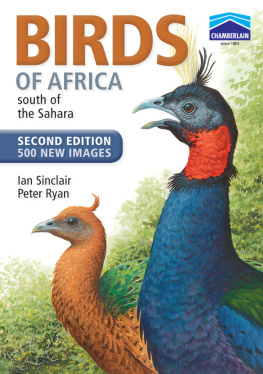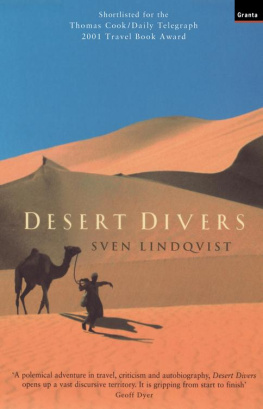STORIES OF THE SAHARA
Foreword
By Sharlene Teo
The Sahara is the largest hot desert in the world and among the most sparsely populated, spanning 103,000 square miles of dunes and flatlands. How did a fiercely cosmopolitan Taiwanese woman end up living in one of the harshest territories on earth? What compelled her to move there? And once she got there, what happened?
Stories of the Sahara , the book that answers these questions, has captivated millions of readers to date. First published in Chinese in 1976 to rapturous success, Sanmaos memoir and travelogue launched its author as a literary celebrity across Asia. Initially serialised in the Taiwanese United Daily News , the candid intimacy and liveliness of Sanmaos writing cemented her status as an enduring cultural icon and figure of quixotic fascination. Coming to public attention during the prohibitive atmosphere of 1970s martial-law era Taiwan, Sanmaos free-spirited itinerancy enthralled readers and demonstrated an exciting model of Asian femininity that centred personal agency, resourcefulness and reinvention.
Across the collection, Sanmao the chimerical protagonist-narrator presents herself as trendsetter and rule-breaker, cool girl and mystic, pensive romantic and comic heroine, globetrotter and housewife. Shes a singular polyglot who refuses to be confined to the limitations of a single category. Shes an unreliable but compelling narrator who embraces contradictions evinced by her plain but assured prose style that shifts from farcical to sombre registers, scatological to highbrow, ludic to deadly serious, often within the same page. There is a wide thematic and emotional range to these pieces; from the high tension and suspenseful dread of Night in the Wasteland and Seed of Death to the ruminative melancholy of Looking for Love and the absurdist comedy of Nice Neighbours and The Desert Bathing Spectacle.
Reading Stories of the Sahara is a transporting and entertaining experience: the reader is brought up close to Sanmaos individuality and independence. As its bestselling popularity attests, readers were drawn to Sanmaos intrepid literary persona, her zest for life and insatiable taste for adventure. Although ubiquitous in the contemporary age of social media and commercialised feminism, Sanmaos unabashed self-aggrandisement and position of gung-ho empowerment was ahead of its time. Her confidence veers on radical. Here is a woman without any medical training who has no compunction assuming the mantle of the local pharmacist or medicine woman. The roguish resourcefulness and wit of the Stories bear the thrill and jaunty energy of the picaresque, as does the memorable cast of characters from the lovelorn grocer Salun to the enigmatic Sergeant Salva and the tragic Shahida.
Day after day, a black sheep like myself, who never even grew up in the desert, strives to dispel the misery of these long, leisurely years with artfulness and pleasure, Sanmao writes in Hearth and Home, one of the essays that instantiates Stories thematic preoccupations with identity, alienation, community and exile. There is a world weariness and sense of melancholy that undercuts and arguably contradicts Sanmaos self-aggrandising and buoyant narrative tone. Her narrative persona is outgoing, neighbourly, empathetic and social. Yet she is plagued with abiding feelings of isolation. Beholding the wasteland, she states: it was hard not to feel some measure of loneliness. But, by the same token, to know that I was wholly alone in this unimaginably vast land was totally liberating.
Sanmaos appealingly direct voice combines artfulness and pleasure with an undeniable curiosity about the natural world and its inhabitants. Every story conveys this infectious capacity for wonder. She sees the humour and anecdotal potential of challenging conditions describing life in the desert as an unfailingly colourful experience and finds the sublime in the quotidian: scattered pieces of driftwood looked like modernist sculptures. In this way, Stories vivid, searing evocations of desert places and spaces, both awe inspiring and hostile, transported readers who lacked the resources to travel. Her accounts of living alongside the Sahrawi, the indigenous people of the Western Sahara, are oftentimes playful and occasionally dangerous and heartbreaking. She describes cross-cultural encounters and the process of adapting to a new community with the empathy and respectful observance of a self-described black sheep and lifelong outsider.
Sanmao was born Chen Maoping in China in 1943 and raised in Taiwan, and throughout her life she travelled to over fifty-five countries. She drew her pseudonym from the famous and beloved long-running Chinese comic strip character Sanmao, a wandering orphan so malnourished that he has only three hairs on his head. Explaining her rationale for adopting the moniker, Sanmao said When I came across Sanmao, the orphan wandering in the streets, I realised there were a lot of poor children struggling to survive. When I began to write, I decided to faithfully record the lives of ordinary people whose voices go unheard. So I chose this name. There are three different identity modes to Sanmao: Chen Ping, her preferred personal name, Sanmao the literary personality, and Echo, the English name she gave herself in order to honour her art teacher.
Sanmao studied in Germany, the United States and Spain, where she met her future husband, Jos Mara Quero. Their progressive and bohemian partnership founded on a shared adventurousness and Joss devotion to Sanmaos uniquely independent spirit forms the emotional underpinning of Stories of the Sahara . As detailed in The Marriage Chronicles, Joss wedding gift to Sanmao is a camel skull, white bones neatly assembled, with a huge row of menacing teeth and two big black holes for eyes. To a delighted Sanmao, this unconventional and macabre artifact was just the thing to capture my heart and Jos was worthy of being called my soulmate. Their differences in nationality and personality are demonstrated to comedic effect across several stories, but so too is the mutual respect, humour and tenderness of their relationship.
Sanmao is refreshingly frank about her feelings for her husband: I had never been passionately in love with him. At the same time I felt incredibly lucky and at ease. From near-death experiences to domestic episodes deploying ludic resourcefulness to handle the deprivations of desert life, Stories of the Sahara transplants the pragmatic challenges and compromises of marriage to an exotic setting. Their love story with all of its domestic foibles and cross-cultural misunderstandings is at once relatable, to deploy the millennial buzzword, and prescient of the increasing ubiquity of transnational relationships in an increasingly globalised world. Their romance is both glamorous and mundane, deeply romantic and humorously practical.
Jos and Sanmao moved to the Spanish Sahara after she read a feature about it in an issue of National Geographic and felt inexplicably and decisively drawn toward that vast and unfamiliar land, as if echoing from a past life. The passages describing its breathtaking scale are written with a mixture of awe and morbidity: the deathly still landscape was like a grim and ferocious giant lying on its side. We were driving along its quietly outspread body.
Is the desert the panacea for a lifetimes homesickness or is it a metaphor for the restlessness and longing that is germane to Sanmaos wandering spirit? The desert conveys infinity and mortal threat, boundlessness and the risk and opportunity of getting lost. It is a palimpsest of mirages and myths of rescue and no return. Eclipsing romantic love, Sanmao reflects upon how deep in my heart, the Sahara desert had been my dream lover for so long Id expected a scorching sun, but instead found a swathe of poetic desolation.
Next page








